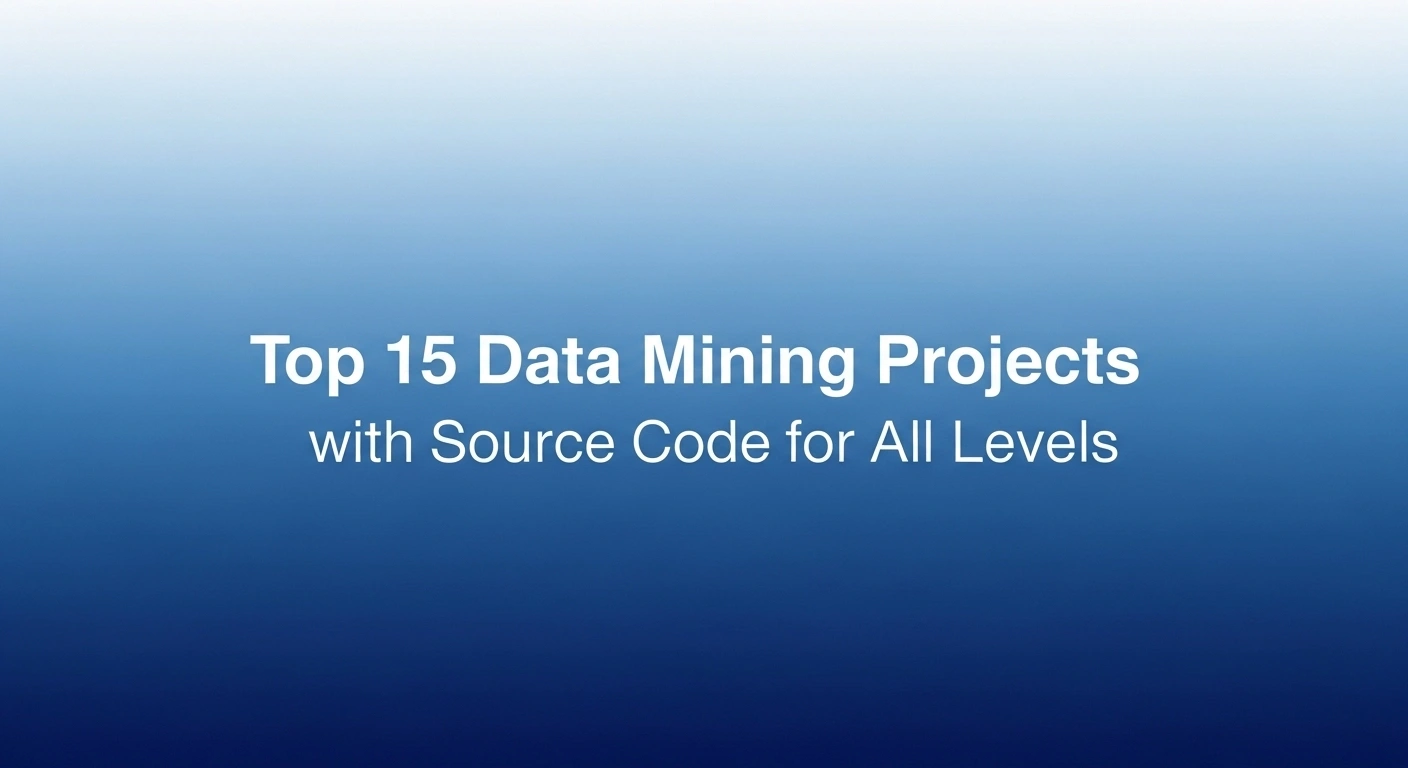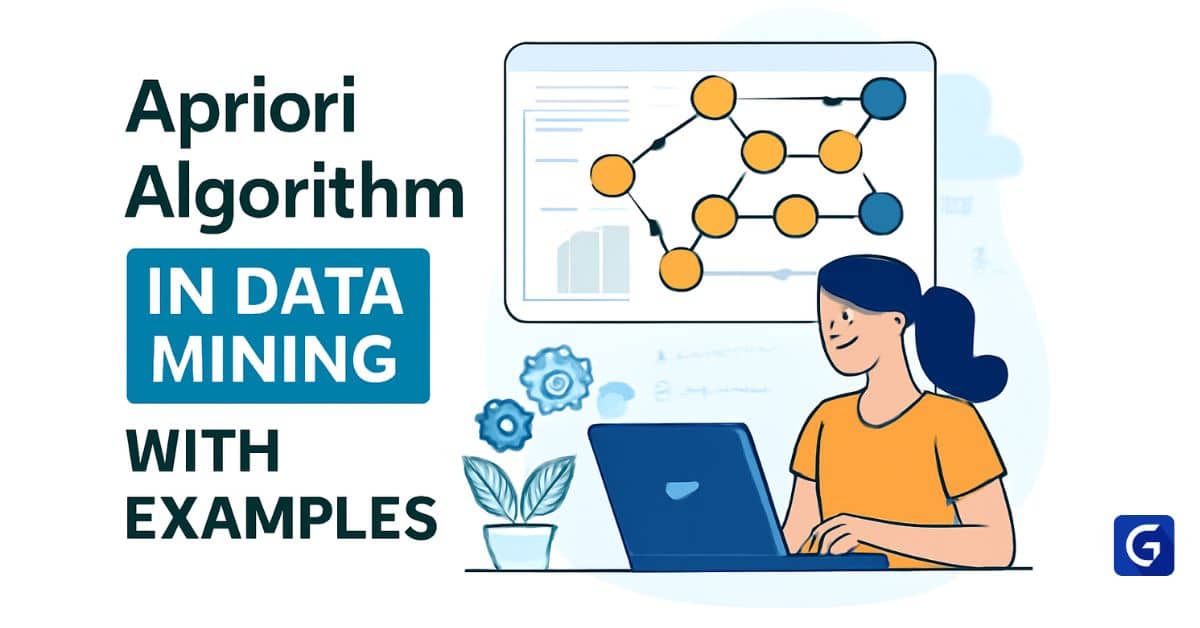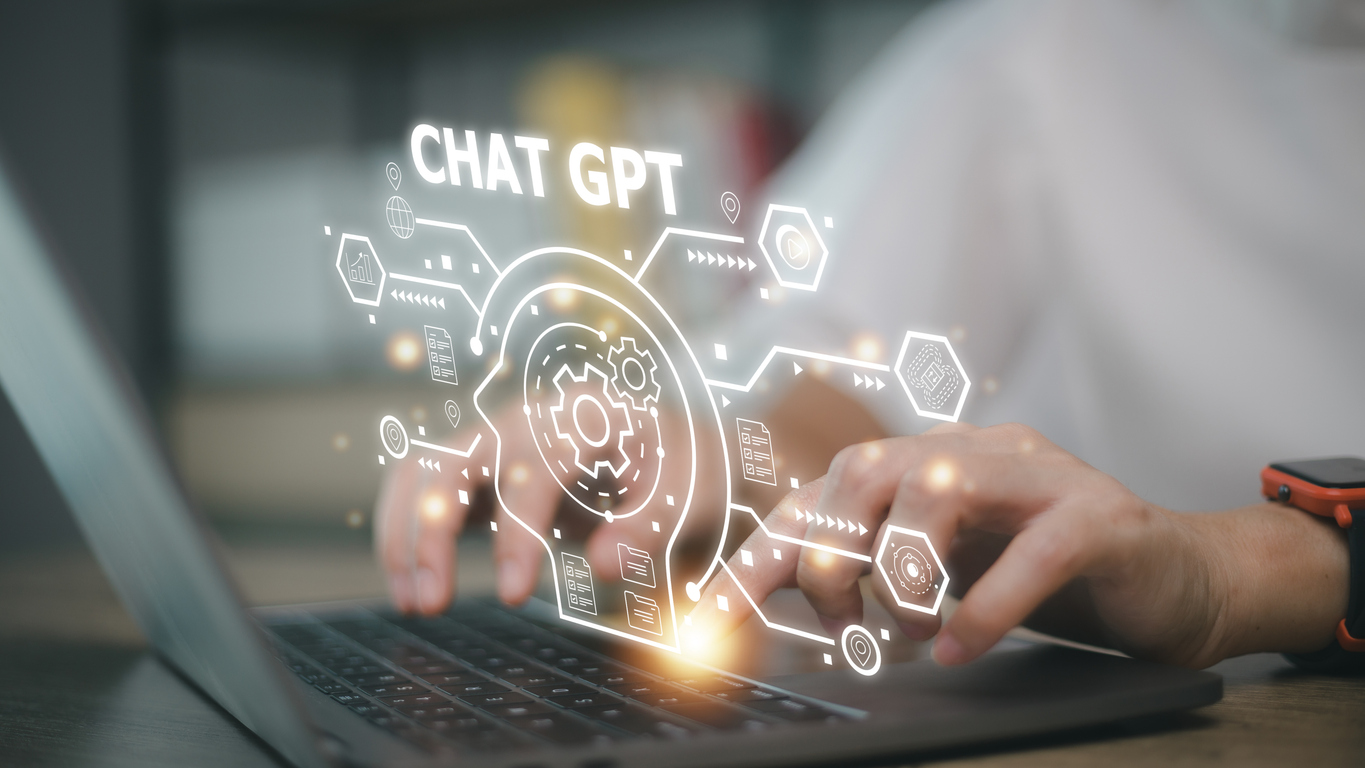This guide includes various data mining projects, starting at a beginner level and going to advanced levels.
Beginning level projects may involve tasks like market basket analysis or customer segmentation - level 2 and 3 projects would cover field's intermediate concepts like fraud detection or sentiment analysis.
Expert-level projects involve advanced tasks that utilize real-time applications and more complex algorithms, such as social network analysis and query recommendation systems.
What is Data Mining?
Data mining, also known as knowledge discovery in databases (KDD), is a process that involves extracting valuable patterns, insights, and knowledge from large datasets. It is a field of study that combines various techniques from statistics, machine learning, and database systems to analyze and discover patterns, correlations, and relationships within data.
Data mining allows organizations to uncover hidden information and make data-driven decisions. By applying algorithms and statistical models, data mining enables the exploration and interpretation of complex datasets to extract meaningful patterns and trends.
Learn Data Mining from basics in this free online training. Learn about Data Description, Data Manipulation, Skewness & a lot more. Best for Beginners. Start now!
Beginner Data Mining Projects
1. Mushroom Classification
Project Details: The objective is to build a highly accurate binary classifier to determine if a mushroom is edible or poisonous based on 22 physical attributes from the UCI Mushroom dataset. The project involves preprocessing a dataset composed entirely of categorical features and then training and visualizing a decision tree model to understand its classification logic.
Features:
- Data preprocessing pipeline to convert categorical text data into numerical format using one-hot encoding.
- Implementation of a Decision Tree Classifier to learn the classification rules.
- Visualization of the trained decision tree to interpret the key features that distinguish edible from poisonous mushrooms.
- Performance evaluation using metrics like accuracy, precision, and recall.
Key Tools & Libraries:
- Python
- Pandas (for data loading and manipulation)
- Scikit-learn (DecisionTreeClassifier, OneHotEncoder, train_test_split)
- Graphviz (to visualize the decision tree)
Tag: Beginner Popularity: High
2. Customer Segmentation with K-Means
Project Details: This project focuses on applying the K-Means clustering algorithm to segment customers from a retail dataset based on their annual income and spending score. The goal is to identify distinct customer groups for targeted marketing. A key part of the project is determining the optimal number of clusters using the Elbow Method.
Features:
- Exploratory data analysis (EDA) to understand the distribution of customer data.
- Application of the Elbow Method to find the optimal value of 'K' (number of clusters).
- Training a K-Means model to assign each customer to a specific segment.
- 2D scatter plot visualization of the final clusters, with centroids, to present the distinct customer groups.
Key Tools & Libraries:
- Python
- Pandas, NumPy
- Scikit-learn (KMeans, StandardScaler)
- Matplotlib/Seaborn (for plotting clusters)
Tag: Beginner Popularity: High
3. Market Basket Analysis for Retail
Project Details: The goal is to discover product purchasing associations from a transactional dataset of a retail store. This project uses the Apriori algorithm to identify "if-then" rules (e.g., "If a customer buys bread, they are likely to buy milk"). The results help in product placement and promotional strategies.
Features:
- Preprocessing of transactional data into a one-hot encoded format suitable for association rule mining.
- Application of the Apriori algorithm to generate frequent itemsets.
- Generation of association rules based on metrics like support, confidence, and lift.
- Analysis of the top rules to derive actionable business insights.
Key Tools & Libraries:
- Python
- Pandas
- MLxtend (apriori, association_rules)
Tag: Beginner Popularity: High
Also Read: What is the Apriori Algorithm in Data Mining
4. Wine Quality Prediction
Project Details: This project involves building a regression or classification model to predict the quality of wine on a scale of 0-10 based on 11 physicochemical attributes (e.g., acidity, sugar, alcohol). It requires data exploration to understand the relationships between chemical properties and wine quality and to select the most influential features.
Features:
- Correlation analysis to identify which chemical features most strongly impact wine quality.
- Training multiple models (e.g., Linear Regression, Random Forest) to predict the quality score.
- Feature importance analysis using the trained Random Forest model.
- Evaluation of model performance using metrics like Mean Squared Error (for regression) or Accuracy (for classification).
Key Tools & Libraries:
- Python or R
- Pandas
- Scikit-learn (LinearRegression, RandomForestClassifier, metrics)
- Matplotlib/Seaborn (for correlation heatmap)
Tag: Beginner Popularity: Medium
5. Predicting Student Performance
Project Details: Analyze a dataset of student demographics, study habits, and social attributes to build a model that predicts their final academic grade. This classification project helps identify key factors that contribute to student success or failure, providing insights for educational interventions.
Features:
- Handling a mix of numerical and categorical data through appropriate preprocessing techniques.
- Training a classification model (e.g., Logistic Regression, Support Vector Machine) to predict performance categories (e.g., pass/fail or grade brackets).
- Analysis of model coefficients or feature importances to identify the most significant predictors of student success.
- Data visualization to explore relationships between variables like study time, failures, and final grades.
Key Tools & Libraries:
- Python
- Pandas
- Scikit-learn (LogisticRegression, SVC)
- Seaborn (for EDA plots)
Tag: Beginner Popularity: Medium
Intermediate Data Mining Projects
6. Handwritten Digit Recognition with CNNs
Project Details: This project involves building and training a Convolutional Neural Network (CNN) to classify grayscale images of handwritten digits (0-9) from the well-known MNIST dataset. It's a foundational computer vision project for learning how to structure and train neural networks for image data.
Features:
- Preprocessing of image data: reshaping, normalizing pixel values, and one-hot encoding labels.
- Construction of a sequential CNN model with convolutional, pooling, and dense layers.
- Training the model on the MNIST dataset and monitoring its accuracy and loss.
- Evaluating the trained model's performance on a separate test set to measure its real-world accuracy.
Key Tools & Libraries:
- Python
- TensorFlow or Keras
- NumPy (for array manipulation)
- Matplotlib (for visualizing sample digits and training history)
Tag: Intermediate Popularity: High
7. Credit Card Fraud Detection
Project Details: Construct a machine learning model to detect fraudulent credit card transactions from a highly imbalanced dataset where fraud cases are very rare. The key challenge is to build a classifier that can effectively identify fraudulent transactions without incorrectly flagging legitimate ones.
Features:
- Handling of a highly imbalanced dataset using techniques like SMOTE (Synthetic Minority Over-sampling Technique) to create a balanced training set.
- Training classification models like Logistic Regression or Random Forest on the processed data.
- Evaluation using metrics appropriate for imbalanced data, such as the ROC-AUC score and the Precision-Recall curve.
- Analysis of a confusion matrix to understand the model's trade-offs between false positives and false negatives.
Key Tools & Libraries:
- Python
- Pandas
- Scikit-learn (LogisticRegression, RandomForestClassifier)
- Imbalanced-learn (SMOTE)
Tag: Intermediate Popularity: High
8. Twitter Sentiment Analysis
Project Details: This project aims to classify the sentiment of tweets as positive, negative, or neutral. It involves significant Natural Language Processing (NLP) work, including cleaning raw tweet text, converting text into numerical vectors, and training a classification model.
Features:
- Text preprocessing pipeline: removing URLs, mentions, hashtags, and stop words; performing tokenization and stemming/lemmatization.
- Feature extraction from text using TF-IDF (Term Frequency-Inverse Document Frequency) to represent tweets numerically.
- Training a classifier (e.g., Naive Bayes or LSTM for a deep learning approach) on the vectorized text data.
- Creating a function to predict the sentiment of new, unseen tweet text.
Key Tools & Libraries:
- Python
- NLTK or spaCy (for text processing)
- Scikit-learn (TfidfVectorizer, MultinomialNB)
- Tweepy (for collecting live tweet data)
Tag: Intermediate Popularity: High
9. Movie Recommendation System
Project Details: Build a movie recommender using the MovieLens dataset. This project implements collaborative filtering, a technique that recommends items based on the preferences of similar users. The goal is to create a function that takes a user ID and returns a list of recommended movies.
Features:
- Implementation of user-based or item-based collaborative filtering.
- Calculation of user-user or item-item similarity using metrics like cosine similarity.
- Generation of a ranked list of movie recommendations for a given user.
- Evaluation of the recommendation engine's performance (optional, using metrics like RMSE).
Key Tools & Libraries:
- Python
- Pandas
- Scikit-learn (pairwise_distances)
- Surprise (a library specifically for building and analyzing recommender systems)
Tag: Intermediate Popularity: High
10. Customer Churn Prediction
Project Details: Develop a model to predict customer churn for a subscription-based service (e.g., a telecom company). The project involves feature engineering to create meaningful variables from customer usage data, training a robust classifier, and interpreting the results to understand the drivers of churn.
Features:
- Feature engineering from raw customer data (e.g., creating tenure groups, calculating average monthly charges).
- Training powerful classification models like XGBoost or LightGBM, which perform well on tabular data.
- Analysis of feature importances to identify the top reasons customers leave.
- Providing a business-focused summary of the model's predictions and actionable insights.
Key Tools & Libraries:
- Python
- Pandas
- Scikit-learn
- XGBoost or LightGBM
Tag: Intermediate Popularity: Medium
Expert Data Mining Projects
11. Image Caption Generator
Project Details: This advanced project combines computer vision and NLP to create a model that generates descriptive text captions for images. It uses a sophisticated encoder-decoder architecture where a CNN extracts visual features from an image, and a Recurrent Neural Network (LSTM) decodes these features into a sequence of words.
Features:
- Implementation of a CNN (like VGG16, pre-trained on ImageNet) as the image feature encoder.
- Implementation of an LSTM network as the caption-generating decoder.
- Merging the encoder and decoder models to create the final image captioning architecture.
- Training the model on a large dataset like COCO or Flickr8k and generating captions for new images.
Key Tools & Libraries:
- Python
- TensorFlow or PyTorch
- OpenCV (for image processing)
- NumPy
Tag: Expert Popularity: High
12. Real-time Hand Tracking
Project Details: Develop an application that uses a live webcam feed to detect and track the position and landmarks of a human hand in real-time. This project leverages a pre-trained, high-performance computer vision model to achieve low-latency tracking suitable for interactive applications.
Features:
- Real-time video stream capture from a webcam using OpenCV.
- Application of a pre-trained hand landmark detection model (like Google's MediaPipe Hands) to each frame.
- Extraction of the coordinates of 21 key hand landmarks.
- Overlaying the detected landmarks and connecting lines onto the video feed to visualize the tracking.
Key Tools & Libraries:
- Python
- OpenCV (VideoCapture)
- MediaPipe (specifically the hands solution)
Tag: Expert Popularity: Medium
13. Query Recommendation System using LSH
Project Details: Build a system that recommends search queries based on a user's current input, using a large log of past queries. To handle the scale, this project implements Locality-Sensitive Hashing (LSH), a technique that efficiently finds approximate nearest neighbors in high-dimensional data, making it faster than traditional methods for finding similar queries.
Features:
- Preprocessing of query logs into a suitable numerical format (e.g., MinHashing signatures).
- Implementation of the LSH algorithm to index the query signatures into hash buckets for fast retrieval.
- A function to take a new query, find its nearest neighbors in the LSH index, and return them as recommendations.
- Evaluation of the trade-off between the speed and accuracy of the LSH-based recommendations.
Key Tools & Libraries:
- Python
- Pandas, NumPy
- Scikit-learn (or custom implementation of MinHash and LSH)
Tag: Expert Popularity: Medium
14. Social Network Analysis for Privacy Ranking
Project Details: This project applies graph theory to a social network dataset to rank users based on their structural privacy risk. It implements the PrivRank algorithm, which identifies users who are susceptible to re-identification attacks by analyzing their position in the network graph and their connections to users with known attributes.
Features:
- Modeling social network data as a graph using nodes (users) and edges (connections).
- Implementation of the PrivRank algorithm, which is a variation of PageRank tailored for privacy analysis.
- Calculating a privacy score for each user in the network.
- Identifying the top 'at-risk' users based on their calculated privacy scores.
Key Tools & Libraries:
- Python
- NetworkX (for graph creation and manipulation)
- Pandas (for data handling)
Tag: Expert Popularity: Low
15. Building a Neural Network Visualizer
Project Details: Create a tool that can load a pre-trained neural network model from a file and render its architecture graphically. This data mining project involves parsing complex model formats (like ONNX or Keras) and building a user interface to display the layers, nodes, and connections interactively.
Features:
- A parser for one or more standard model formats (e.g., ONNX, TensorFlow Lite, Keras H5).
- A rendering engine (using web technologies or a desktop GUI toolkit) to draw the network graph.
- User interface to zoom, pan, and inspect individual layers and their properties (e.g., activation functions, filter sizes).
- Cross-platform deployment as a web application or a standalone desktop app using Electron.
Key Tools & Libraries:
- JavaScript (for web/Electron version)
- Python (for model parsing backend)
- Electron.js
- Protobuf (for parsing ONNX files)
Tag: Expert Popularity: Medium
Suggested Reads:






